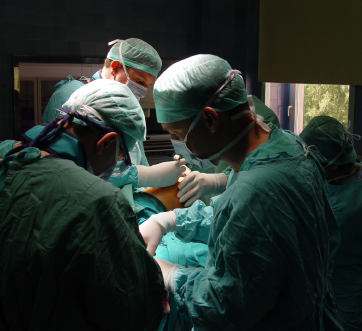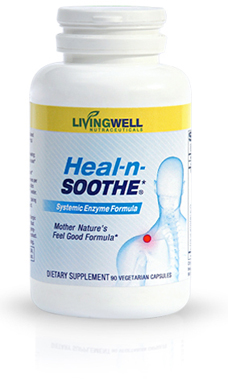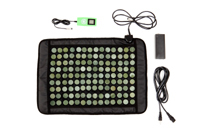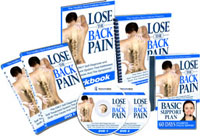An Important and Disturbing Example Why You Must Beware of Back Surgery!
 In 2010, 68-year-old Lillian Kaulback had surgery for her severe back pain — a three-level spine fusion performed by Dr. Aria Sabit of Ventura, California. Kaulback developed a life-threatening infection following the surgery and lost her ability to walk. Seven months later, she passed away.
In 2010, 68-year-old Lillian Kaulback had surgery for her severe back pain — a three-level spine fusion performed by Dr. Aria Sabit of Ventura, California. Kaulback developed a life-threatening infection following the surgery and lost her ability to walk. Seven months later, she passed away.
Her son is now suing Dr. Sabit for wrongful death, claiming that he performed a riskier procedure than necessary in order to profit financially. Among the disturbing revelations in the case reported by CBS News[i] is the fact that Dr. Sabit was a part owner of Apex Medical Technologies, LLC, the company that supplied the screws and rods used to fuse Kaulback’s spine.
While the case is ongoing, it is not an isolated event. Physician-owned companies (also known as physician-owned distributorships, or P.O.D.s) supply about one-sixth of spinal implants in the United States. While some simply buy wholesale implants and then sell them to hospitals at a profit, others design and manufacture their own products. The obvious conflict of interest that results is concerning, to put it mildly, especially in light of the increasing rate of spinal surgeries across the country.
Is Your Doctor Moonlighting as a Salesperson?
If your doctor recommends you receive any type of surgery, you want to know that it’s because you really need it … not because he or she is trying to create a market for surgical devices being sold on the side. But, as you might suspect, a new study by the Inspector General of the Department of Health and Human Services revealed that spinal surgeries do, in fact, increase at hospitals served by physician-owned companies.[ii]
CBS News reported:[iii]
“The report found that in fiscal year 2012, hospitals served by physician-owned companies averaged 28 percent more spine surgeries. Their rate of spine fusions jumped 21 percent after they began purchasing from these companies (that compares to a 9 percent increase for hospitals overall, during the same period). The report also found that surgeries involving physician-owned companies used 13 percent fewer devices.
Drs. Scott Lederhaus and Charles Rosen are on the board of the Association for Medical Ethics. Both spine surgeons, they say they’ve seen many patients harmed by physician-owned companies, due to the strong financial incentive to perform unnecessary procedures. “The guys that are being egregious could make, just from putting in the implants … perhaps in excess of a half a million dollars each, per year,” Lederhaus told “CBS This Morning.”
“Doctors are not supposed to be salesmen,” Rosen added.”
You probably won’t know if your doctor has a stake in spinal surgery devices, either. The report found that hospitals’ policies varied on whether they required physicians to disclose such information to hospitals or patients. In the case of Lillian Kaulback, Dr. Sabit reportedly never mentioned his connection with Apex Medical Technologies that supplied devices for her surgery. Perhaps if he had, she may have thought twice about the extensive surgery, or at least sought a second opinion first …
Are You Considering Spinal Fusion Surgery?
Tragedies like the death of Lillian Kaulback may make you think twice if you’re about to go under the knife to ‘cure’ your back pain … and you know what? They should.
Spinal fusion surgery is an invasive, typically three- to four-hour procedure, in which two or more bones in your spine (the vertebrae) will be essentially “welded” together so they form a single bone that can no longer move.
During the procedure, a bone graft will be placed between vertebrae or over the back part of your spine to fuse the bones together permanently. Rods, screws, plates or cages may also be used to keep your spine from moving until the bone grafts have fully healed, a process that can take several months.
It would be one thing if spinal fusion surgery were incredibly effective. But, in reality, when you fuse together vertebrae in your spine, it impacts the flexibility of your spine and may, in some cases, actually increase spine degeneration.[iv] Far from improving patients’ quality of life, spinal fusion surgery is associated with a significant increase in disability, opiate painkiller use, and prolonged inability to work.[v] One study also found that it was no more effective than intensive rehabilitation in reducing disability among people with chronic low back pain.[vi]
For this privilege, you may pay up to $90,000 per procedure … and did we mention that in many cases a second procedure is necessary? And as illustrated by the featured case above, there are considerable risks associated with spinal fusion surgery, which include:
- Infection
- Bleeding
- Persistent pain at graft site
- Recurring symptoms
- Pseudarthrosis, a condition where there is not enough bone formation and a second surgery may be required
- Nerve damage, which may lead to pain, loss of sensation, weakness or bowel and bladder problems
- Blood clots
- Damage and stress to the vertebrae above and below the fusion, increasing your risk of additional future back problems
- Potentially deadly cardiac events (there are nearly 7 cardiac complications per 1,000 lumbar spine surgeries[vii])
So even if your physician is honest and not involved in any conflicts of interest by owning or selling surgical devices, there’s still very good reason to think long and hard before getting surgery for back pain.
Drugs Probably Won’t Give You the Lasting Relief You’re After Either
If you want to avoid spinal surgery, you may think that painkillers and anti-inflammatory drugs are the next-best option. Not so. Many people with back pain are only hurting themselves further — physically and financially — by regarding drugs as an acceptable solution. They do nothing to address the real reasons why you’re in pain, which I’ll get to shortly, but, even worse, they are downright dangerous for your health.
- NSAIDs, including even over-the-counter options like aspirin, are notorious for being hard on your gastrointestinal tract, leading to potentially fatal side effects such as bleeding in your digestive tract, ulcers and perforation of your stomach or intestines.
- All prescription NSAIDs, including Celebrex, ibuprofen and naproxen, can increase your risk of a deadly heart attack or stroke. Celebrex, in particular, has been found to pose unacceptably high heart attack risks.
- Opioid painkillers stimulate pleasure-perceiving areas in your brain, leading to an initial rush of euphoria that some people find impossible to resist. Along with developing physical dependence on the drugs, some people also become quickly addicted. Prescription drug overdoses now cause more overdose deaths than cocaine and heroin combined,[viii] and their numbers are on the rise.
- If you take too much acetaminophen (Tylenol) — which is extremely easy to do if you take multiple over-the-counter medications – you could suffer from fatal liver damage. Acetaminophen products may also cause fatal skin reactions, according to a warning from the US Food and Drug Administration (FDA).
Did You Know There are Proven Non-Surgery, Non-Drug Options for Back Pain?
Worrying about whether or not you really need spinal surgery, or whether the drugs for your back pain are going to cause dangerous side effects, is stressful. It’s also completely unnecessary, because there is no automatic need for surgery and drugs if you have back pain.
In fact, I would urge you to not even consider them until you’ve tried the three safe non-drug, non-surgery approaches that follow:
1. Proteolytic Enzymes
 Also known as proteases, proteolytic enzymes are a type of digestive enzyme that help digest animal proteins. But, far more than this, proteolytic enzymes can migrate to other parts of your body, such as your bloodstream, where they literally seek and destroy other protein “danger zones,” like cancer cells’ coatings, scar tissue, hardened proteins and blood vessels packed with fibrin. These powerhouse enzymes work systemically to fight inflammation in your body.
Also known as proteases, proteolytic enzymes are a type of digestive enzyme that help digest animal proteins. But, far more than this, proteolytic enzymes can migrate to other parts of your body, such as your bloodstream, where they literally seek and destroy other protein “danger zones,” like cancer cells’ coatings, scar tissue, hardened proteins and blood vessels packed with fibrin. These powerhouse enzymes work systemically to fight inflammation in your body.
As a leading cause of diseases ranging from heart disease and cancer to rheumatoid arthritis and diabetes, and a leading cause of pain, curbing chronic inflammation is key to maintaining your health.
Proteolytic enzymes are naturally produced in your pancreas, but your natural production declines with age; these inflammation-busters become largely depleted as you hit 40 and over. In fact, a newborn baby has 100 times more enzymes than an elderly person, and even a 20-year-old has double the enzyme levels of a 70-year-old. If you have blood-clotting disorders, chronic fatigue, high cholesterol, obesity or other chronic health ailments or even grey hair, these could be signs that you’re already enzyme deficient.
Fortunately, there’s Heal-n-Soothe, the best systemic enzyme formula to replenish your body’s supply of vital proteolytic enzymes. Heal-n-Soothe®” not only gives you the healing power of proteolytic enzymes in a convenient capsule but it also goes where no other proteolytic supplement has or will with 12 additional pain-relieving anti-inflammatories from nature.
2. Far-Infrared Heat
 Heat has been scientifically proven to provide pain relief in people with low back pain,[ix] but the conventional heat given off by most heating pads will only warm the surface of your skin, offering only minimal, short-lived relief. Heat from far-infrared rays (FIR), on the other hand, penetrates your skin as deep as 3 inches, compared to just 2-3 millimeters of other pads.
Heat has been scientifically proven to provide pain relief in people with low back pain,[ix] but the conventional heat given off by most heating pads will only warm the surface of your skin, offering only minimal, short-lived relief. Heat from far-infrared rays (FIR), on the other hand, penetrates your skin as deep as 3 inches, compared to just 2-3 millimeters of other pads.
This is why FIR heat is so completely different from conventional heat … and why FIR’s energy is able to reach deep into your body, zero in on your pain, and speed natural healing. Even better, because the heat is deep heat, the soothing relief lasts; it won’t just dissipate the second you turn it off.
Far-infrared rays lead to vibration effects at the molecular level, which improves transportation of oxygen and nutrients, ultimately helping to support regeneration and healing.[x]
For deep, healing heat that acts on your tissues thermally, helping to soothe muscle aches and pains, LosetheBackPain.com’s Far-Infrared Back Pain Heating Pad just can’t be beat.
3. Lose the Back Pain System — Address the ROOT Cause of Your Pain
 Physical dysfunctions develop over time — the result of poor posture, repetitive stresses, sitting too much, and so on – and are the direct result of imbalances between various muscle groups, i.e. “muscle imbalances.” Your body is then forced to work each day with this dysfunction and eventually this creates a condition, like a herniated disc or a pinched nerve, for example.
Physical dysfunctions develop over time — the result of poor posture, repetitive stresses, sitting too much, and so on – and are the direct result of imbalances between various muscle groups, i.e. “muscle imbalances.” Your body is then forced to work each day with this dysfunction and eventually this creates a condition, like a herniated disc or a pinched nerve, for example.
Then the condition causes lumbar pain, and maybe associated pain in your upper back, buttocks, legs, shoulders and neck, and as you know, pain is your body’s way of alerting you to a problem that needs to be fixed …Â and the solution starts at the foundational level with your original muscle imbalances.
With the Lose the Back Pain System, you’ll first identify the causes of your dysfunctions and muscle imbalances, then implement proven strategies to help reduce and manage your pain so you can focus on correcting the dysfunction(s) that are causing it. You will work on treating the causes and also implementing additional treatments and strategies that are specific to the condition you may have been diagnosed with.
This is a safe, straightforward system that works to heal your pain at the very root, foundational level, and it should be your go-to solution if you’re currently struggling with pain. Please, try this first before you consider spinal fusion surgery that might increase your back pain … or worse!
LISTEN NOW: Back Pain Treatments Reviewed
(click above to listen to this short & informative presentation)

